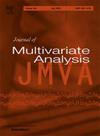Measuring and testing tail equivalence
IF 1.4
3区 数学
Q2 STATISTICS & PROBABILITY
引用次数: 0
Abstract
We call two copulas (lower) tail equivalent if their first-order approximations in the lower tail coincide. As a special case, a copula is called tail symmetric if it is tail equivalent to the associated survival copula. We propose a novel measure and statistical test for tail equivalence. The proposed measure takes the value of zero if and only if the two copulas share a pair of tail order and tail order parameter in common. Moreover, taking the nature of these tail quantities into account, we design the proposed measure so that it takes a large value when tail orders are different, and a small value when tail orders are the same but tail order parameters are non-identical. Therefore, the measure admits attribution of the difference in two tails to that in tail orders or in tail order parameters. We derive asymptotic properties of the proposed measure, and then propose a novel statistical test for tail equivalence. The performance of the proposed test is demonstrated in a series of simulation studies and empirical analyses of financial stock returns in the periods of the global financial crisis and the COVID-19 recession. Our empirical analysis reveals non-identical tail behaviors in different pairs of stocks, different parts of tails, and the two periods of recessions.
测量和测试尾部等效性
我们称两个copula(下)尾等价,如果它们在下尾的一阶近似重合。作为一种特殊情况,如果一个联结体的尾与相关的生存联结体相等,则称为尾对称联结体。我们提出了一种新的尾部等效度量和统计检验方法。当且仅当两个联结体有一对尾序参数和尾序参数相同时,该测度取零值。此外,考虑到这些尾量的性质,我们设计了所提出的度量,使其在尾订单不同时取大值,在尾订单相同但尾订单参数不相同时取小值。因此,该措施承认两个尾部的差异归因于尾顺序或尾顺序参数的差异。我们推导了所提出测度的渐近性质,然后提出了一个新的尾部等价的统计检验。通过对全球金融危机和新冠肺炎经济衰退期间金融股收益的一系列模拟研究和实证分析,证明了该测试的有效性。我们的实证分析表明,在不同的股票对、尾巴的不同部分和两个衰退时期,尾巴的行为是不相同的。
本文章由计算机程序翻译,如有差异,请以英文原文为准。
求助全文
约1分钟内获得全文
求助全文
来源期刊

Journal of Multivariate Analysis
数学-统计学与概率论
CiteScore
2.40
自引率
25.00%
发文量
108
审稿时长
74 days
期刊介绍:
Founded in 1971, the Journal of Multivariate Analysis (JMVA) is the central venue for the publication of new, relevant methodology and particularly innovative applications pertaining to the analysis and interpretation of multidimensional data.
The journal welcomes contributions to all aspects of multivariate data analysis and modeling, including cluster analysis, discriminant analysis, factor analysis, and multidimensional continuous or discrete distribution theory. Topics of current interest include, but are not limited to, inferential aspects of
Copula modeling
Functional data analysis
Graphical modeling
High-dimensional data analysis
Image analysis
Multivariate extreme-value theory
Sparse modeling
Spatial statistics.
 求助内容:
求助内容: 应助结果提醒方式:
应助结果提醒方式:


